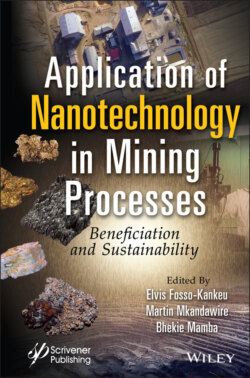Читать книгу Application of Nanotechnology in Mining Processes - Группа авторов - Страница 16
1.2.3 Classical AMD Remediation and Treatment Methods
ОглавлениеThe effects of AMD on the environment are enormous, and several remediation technologies have been implemented (Figure 1.2) depending on the geographical conditions and weather effects of the mining sites to ensure environmental compliance. Over the past decades, neutralization techniques involving active and passive methodologies have been employed, and a detailed description of these technologies was reported by Naidu et al., including a few case studies on actual mining sites [46]. However, these technologies still have some shortcomings and call for logical approaches to enhance their effectiveness. Active treatment technologies use neutralizing agents, such as CaCO3, Ca (OH)2, CaO, Na2CO3, NaOH, and NH3, that produce sludge or precipitates heavily laden with metals and REEs, which require suitable disposal methods, making the procedure very expensive [47].
Figure 1.2 Schematic of the different types of remediation techniques for ARD neutralization or prevention.
Similarly, passive treatments, although being the least expensive approach, also make use of neutralizing agents. This technology is effective in mine waste with low acidic content and minimal water flow rate fluctuation. The major drawback of passive technology is that it requires a lengthier operative time for effective remediation, compromising its usage in modern mining activities [48]. Although investigations and pilot analysis have indicated that active and passive approaches can positively handle AMD [49], the continuous use of chemicals to neutralize AMD has raised some environmental concerns, making this procedure unsustainable and costly. In avoiding the use of excess chemicals, Tabelin and coworkers introduced two passivation techniques known as microencapsulation and galvanic microencapsulation techniques that could potentially prevent pyrite oxidation at the point source. The microencapsulation technique uses a redox-reactive organic carrier that is highly sensitive to pyrite in mine tailings to coat pyrite surfaces and thus prevent AMD formation. Meanwhile, galvanic encapsulation is based on galvanic interactions between pyrite and metals with lower rest potentials to suppress the oxidation of sulfide minerals [50]. However, these methods are not sufficient as they only suppress sulfide oxidation on a temporary basis, besides which sulfide oxidation is a natural process that is slow and difficult to prevent. A recent study has shown that active and passive biological remediation techniques offer great advantages, permanently removing sulphate and metals from mine drainage and having a high ability to recover the valuable metals [51]. However, the shortcomings of these methods is the high cost involved and the difficulty in setting up the processes, calling for a more sustainable and cost-effective technique for the remediation of AMD from mining MSWs.
